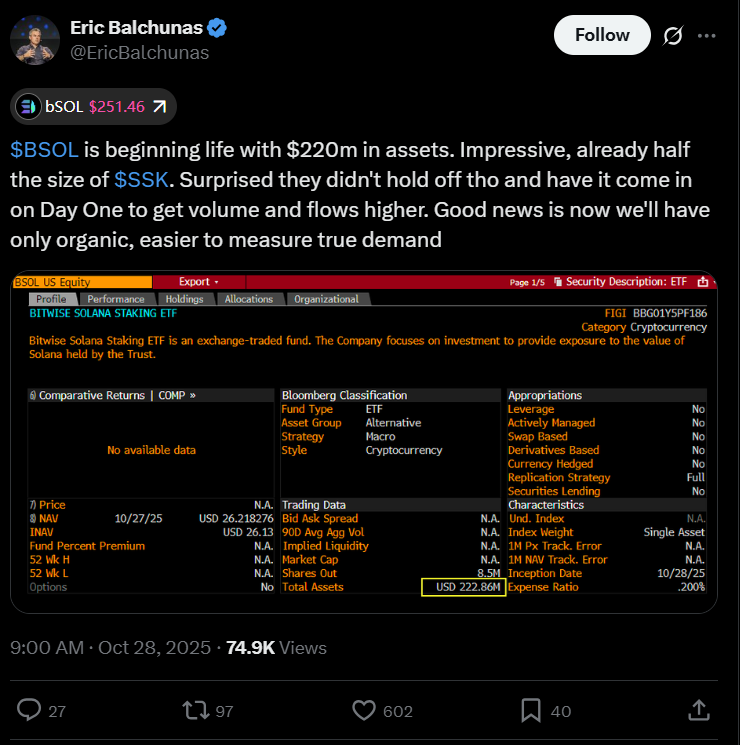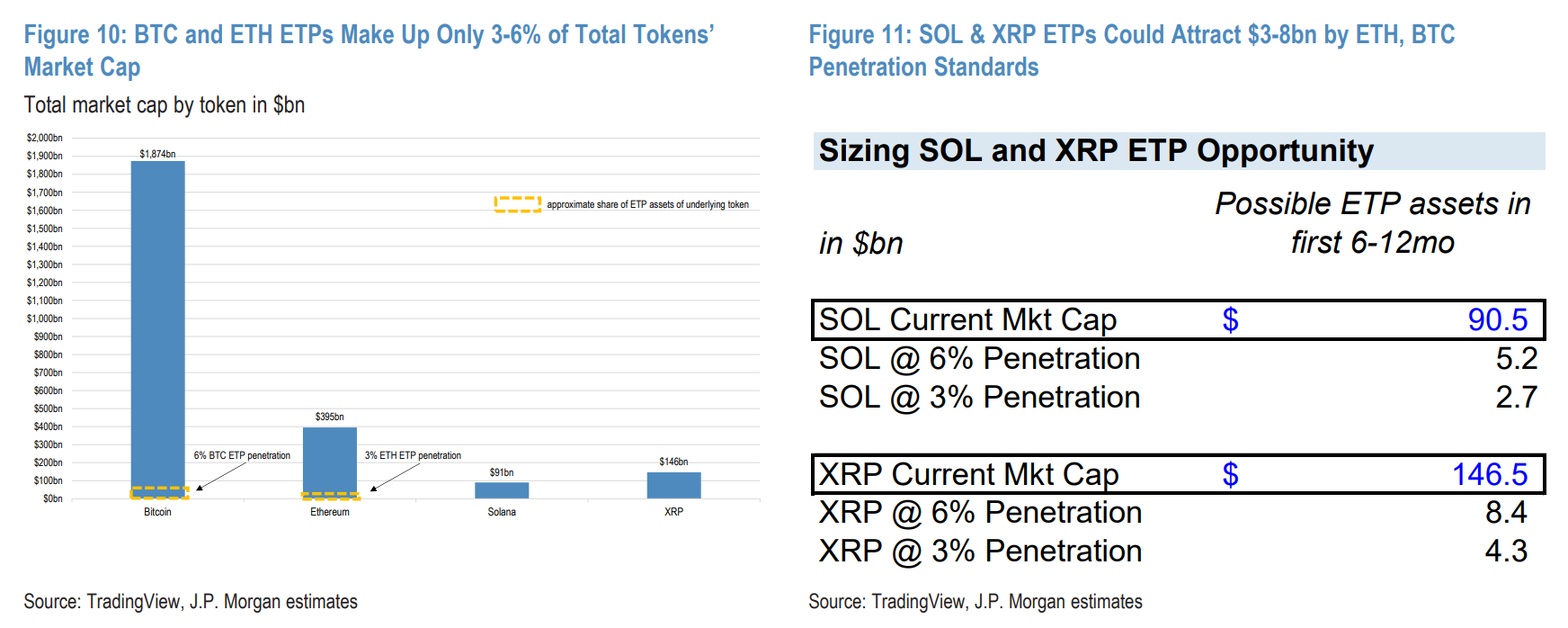The Bitwise Solana Staking ETF (BSOL) attracted $222.8 million in assets on its first trading day, signaling robust US investor interest in staking-based crypto products following recent SEC clarifications on proof-of-stake activities.
-
Strong inflows highlight growing demand for Solana staking ETFs amid regulatory progress.
-
Bitwise’s product offers exposure to SOL with an estimated 7% yield from network staking rewards.
-
Analysts from Bloomberg Intelligence note this debut as significant for new crypto ETFs, with potential billions in future inflows per JPMorgan projections.
Discover how Bitwise Solana Staking ETF’s $222.8M launch boosts crypto ETF adoption. Explore staking yields and SEC updates for investors seeking Solana exposure. Stay ahead in 2025 trends.
What is the Bitwise Solana Staking ETF?
The Bitwise Solana Staking ETF (BSOL) is the first US-listed exchange-traded fund providing investors with exposure to Solana (SOL) cryptocurrency while generating yields through network staking activities. Launched on Tuesday, it quickly amassed $222.8 million in assets under management, as reported by Bloomberg Intelligence senior ETF analyst Eric Balchunas. This product allows US investors to participate in Solana’s proof-of-stake ecosystem without directly managing staking, offering an estimated 7% annual yield from rewards.

Source: Eric Balchunas
Bitwise had previously introduced a similar Solana staking product in Europe last year, but the US launch was delayed due to prior regulatory uncertainties around staking. The ETF’s debut follows the REX-Osprey Solana Staking ETF (SSK) on June 30, which recorded about $12 million in first-day volume. These developments stem from the US Securities and Exchange Commission’s Division of Corporation Finance issuing a staff statement on May 29, clarifying that certain proof-of-stake activities do not qualify as securities offerings under federal law. An August follow-up statement further included provisions for liquid staking arrangements, paving the way for such products.
How Does Regulatory Clarity Impact Solana Staking ETFs?
Regulatory clarity from the SEC has been pivotal in enabling the launch of staking-focused ETFs like BSOL, reducing legal ambiguities that previously hindered US offerings. According to Bloomberg Intelligence, the $222.8 million inflow on day one underscores heightened institutional confidence in these instruments. Eric Balchunas, a senior ETF analyst at Bloomberg Intelligence, described the figure as notably large for a new crypto ETF, reflecting broader market enthusiasm for Solana’s efficient blockchain.
Solana’s network, known for its high throughput and low transaction costs, benefits from staking where participants lock SOL to validate transactions and earn rewards. The BSOL ETF structures this exposure compliantly, allowing indirect participation. Data from network analytics shows Solana’s staking ratio consistently above 70%, supporting stable yields around 7%. Experts, including those from JPMorgan, anticipate this clarity will accelerate approvals for other altcoin ETFs, potentially channeling significant capital into the sector.
Institutional demand for crypto exchange-traded funds remains robust, building on the success of spot Bitcoin ETFs in early 2024 and Ether ETFs later that year. Analysts observe a shift toward alternative assets like Solana, driven by diversification needs among portfolio managers. JPMorgan’s January projections estimated that Solana ETFs could attract $3 billion to $6 billion in inflows within the first six months, possibly surpassing Ether’s initial performance based on comparable adoption patterns.

JPMorgan estimates potential inflows into SOL and XRP ETFs. Source: JPMorgan
These forecasts align with observed trends, where Bitcoin and Ether funds drew substantial investments post-approval. For Solana, the staking feature adds appeal by providing passive income, differentiating it from non-yielding spot products. Bloomberg Intelligence data indicates that over 50 new ETF filings for various cryptocurrencies are pending, with staking variants gaining traction due to yield potential. K33 Research analysts have noted that major players like BlackRock’s involvement could further amplify inflows, though Bitwise’s independent launch demonstrates widespread market readiness.
Frequently Asked Questions
What Are the Key Benefits of Investing in the Bitwise Solana Staking ETF?
The Bitwise Solana Staking ETF offers US investors easy access to Solana’s growth potential and staking yields without the complexities of direct crypto management. With $222.8 million in first-day assets and an estimated 7% yield, it provides diversified exposure to a high-performance blockchain. This product suits those seeking regulated vehicles for crypto allocation, backed by SEC-approved staking mechanisms.
Why Did the Solana Staking ETF Launch in 2025?
The Solana staking ETF launched in 2025 following SEC statements in May and August 2024 that clarified proof-of-stake activities as non-securities. This regulatory green light resolved prior delays, enabling Bitwise to bring BSOL to US markets after a European version debuted the previous year. It reflects evolving oversight that supports innovative crypto products while protecting investors.
Key Takeaways
- Record-Breaking Debut: BSOL’s $222.8 million inflows on launch day signal strong US demand for staking ETFs, per Bloomberg Intelligence analysis.
- Regulatory Milestone: SEC clarifications on PoS and liquid staking have unlocked new opportunities, potentially leading to billions in altcoin ETF investments as forecasted by JPMorgan.
- Yield and Accessibility: Investors gain 7% staking rewards on Solana through a compliant ETF structure, ideal for institutional portfolios seeking crypto diversification.
Conclusion
The launch of the Bitwise Solana Staking ETF marks a significant advancement in US crypto investment options, with its impressive first-day performance highlighting investor enthusiasm for Solana staking amid favorable regulatory shifts. As institutional interest grows, products like BSOL demonstrate the maturing integration of blockchain yields into traditional finance. Looking ahead, continued SEC guidance could spur further innovations, encouraging investors to explore staking-based ETFs for long-term portfolio enhancement.






